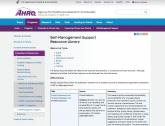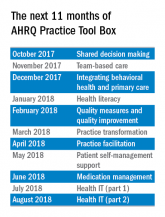Opinion

Medication management
- Author:
- Theodore Ganiats, MD
Publish date: June 5, 2018
This month, Dr. Theodore Ganiats examine some of AHRQ's other tools and resources to assist with medication management.
Opinion

Integrating behavioral health into primary care
- Author:
- Theodore Ganiats, MD
Publish date: February 2, 2018
In the name of quality primary care, AHRQ offers online structured, standardized summaries containing information about measures and their...
Opinion
The AHRQ Toolbox: Tools for negotiating shared decision making
- Author:
- Arlene S. Bierman, MD
- Theodore Ganiats, MD
Publish date: September 30, 2017
AHRQ aims to strengthen the practice of medicine and it has tools.
News

The AHRQ Practice Tool Box
- Author:
- Arlene S. Bierman, MD
- Theodore Ganiats, MD
Publish date: September 19, 2017
New columns showcase tools to help physicians manage the complexities of primary care.
Article
The Far-Reaching Consequences of a Diagnosis
- Author:
- William A. Norcross, MD
- Barbara Ryan
- Nicole Chauche, MD
- Theodore Ganiats, MD
- Jean Nidorf, PhD
- Diane Mason, Lcsw
